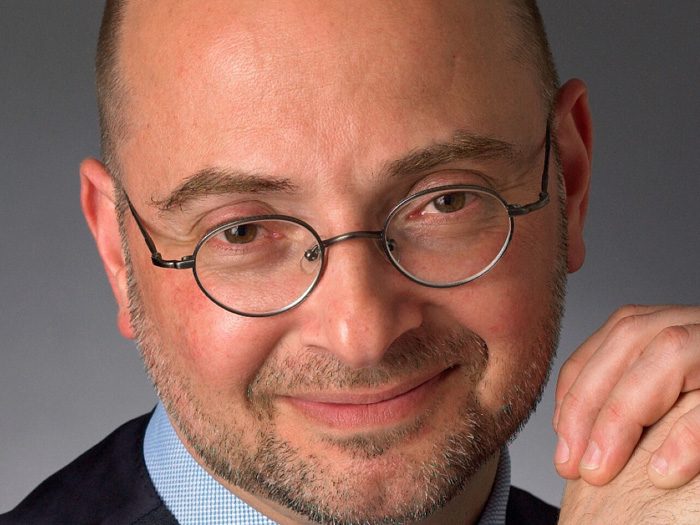12 Questions for Steel City Re’s Nir Kossovsky, Part Two

In part one of this Q&A, Steel City Re co-founder Nir Kossovsky discussed the possibility that class action filings will increase after recent stock market volatility.
Now, his conversation with Risk & Insurance® continues, edited for length and clarity.
Risk & Insurance: So let’s talk about the insurance side of the exposures we’ve listed.
Nir Kossovsky: Some of the magic words and the complaints are “and have destroyed the reputation of the firm.”
In 2005, the industry came up with this concept of reputation being the risk of risks. It was the overarching risk. It was the industry’s framing of this thing that the accountants called extra financial information. The stuff beyond the financial statements. The things that gave you a sense of the character of the firm.
What made people tick? What did they care about? The social interest. The environmental interest. The governance interest. The equity interest. The sustainable interest.
How innovative are they? Get beyond the financials and give me some sense of what the company’s all about. That extra financial stuff, the accountants called it.
PwC did this study around 2003/04 that showed the companies more liberal in their disclosure of extra financial information tended to get more buy recommendations from buy-side analysts, because they felt they knew the company better. Financials tell a lot on where things are at, they give a sense of budgetary priorities and so on.
They don’t give you so much of an idea of where the company’s going to go, because you don’t know what’s in the head of the leadership; the extra financial information does. It gives you a sense of what they care about, where they’re going, what they value.
That gives you a better way to get a sense of where the future’s going to be. That statement I just uttered is essentially the same argument the SEC has been making in terms of why it wants all these disclosures in the 10-K, to give investors a better sense of what companies are doing because investors have been asking for this ever since PwC showed that extra financial information counts.
That’s 2003/04. The risk industry, at least The Economist called it, “the risk of risks.” That term crowned reputation of risk.
The marketing people jumped in and concluded that the risk of risk and reputation is all based on corporate social responsibility and how a company presents itself. And we can present ourselves by showing that we’re responsible in marketing, grab that concept from the risk people and say, “we’re going to run with it and tell a good story about company’s being responsible entities, so that investors will know that we’re responsible.
“We’ll do that by donating money to places and getting ourselves involved in things and getting behind causes.”
Around the same time, the UN was talking about words like ESG. E,S and G: environmental, governance, social justice. The investment community grabbed it around 2019 with the Business Roundtable.
At least within the financial community, the letters ESG became sacrosanct. Outside the investment community, most people have no idea what everybody’s talking about. They’re still in the CSR era. Most companies that had ESG issues changed their CSR to ESG.
ESG replaced CSR as the proxy for a way of telling what a company is all about beyond the financials. In our world, it’s always been reputation.
I’d frame it even a little bit more elegantly, reputation is that which is mission critical to a firm and mission critical is that which stakeholders care about, whatever it might be.
Let’s begin with one size does not fit all.
ESG is not something imposed from the outside. It doesn’t have a magic answer. It depends on what a firm’s stakeholders expect from the firm. It’s not industry-specific. It’s not sector-specific, it’s company specific.
Now, there are some overlaps when you’re in certain industries, but different companies attract different investors, different employees; they have different social license holders because they operate in different environments. They have different regulators. Those are the stakeholders who have expectations.
That’s where reputation arises from in terms of their expectations, which define what is mission critical to a firm. And if the firm meets the expectations or manages the expectations, then it’s addressing and overseeing that which is mission critical.
R&I: What tools that you employ do you see having an impact in this area?
NK: The answer is, the same way we’ve been addressing reputation for the last 10 years. At the end of the day, it’s all about reputation.
We address it parametrically. Parametric is a very fancy word for basically insuring to model. Insuring to model means that you’re building in basis risk because you’re insuring to a model, not to reality.
Of course, reality has adjudication, and adjudication introduces all sorts of basis risk as well and claims adjustment, but there’s obvious basis risk in insuring to a model.
On the other hand, it’s efficient and it’s well understood.
The obvious value of a parametric approach in ensuring to a model is that it’s easy to underwrite, easy to adjust, which reduces a lot of the cost for insurer. It reduces a lot of the uncertainty for an insured and it takes the entire legal dispute out of the equation. It either is or isn’t, and it’s transparent to all.
The only rate-limiting steps to a parametric solution for any exposure is whether the buyer and seller of risk or insurance agree that the model is adequate. No model is perfect.
To the extent that a buyer and seller of insurance risk … and everybody seems to like the Kelley’s Blue Book, that’s clearly a very useful model for insurance, to the extent that a buyer and seller will agree that a model is useful, it can underpin any risk transfer model and inverse transfer process through parametric insurance. It’s that simple.
The art is producing a reasonable model and proving that it’s reasonable. And then getting the buy-in that it’s acceptable.
Steel City redeveloped a model for approximating this notion of reputational value, and it’s sort of validated itself in the equity markets over the years. It’s been used for all sorts of clever equity or arbitrage strategies and so on.
It’s a good model and it’s a useful model. It’s certainly not a perfect model, but it’s good enough for parametric insurance for very complex exposures.
And obviously, in the environment that we’re discussing where the allegation is a damage to reputational value, it’s a perfect model for ensuring reputation risk arising from an alleged failure to oversee or disclose or mis-disclose or any of the things that involve class action, derivative litigation.
The other benefit is that the very process of insuring actually provides evidence that a firm is in the state of control and is overseeing and managing risk. The very process requires that these things be tracked. So, it’s a curative risk transfer solution.
R&I: That evidence of a state of control that you phrased, is that a bulwark against litigation to some degree in your experience?
NK: Absolutely. It’s an absolute bulwark against litigation.
It works this way, in derivative litigation, if a board is engaged in some process of overseeing and managing something, which is part of what our metrics provide in the course of our underwriting and supporting a firm.
A board may make a bad decision on the basis of the data but as long as there’s a process evidenced, the courts will defer to the process and lump any bad decision as a bad decision, which eliminates culpability, because it’s exempted under the business judgment rule in Delaware.
R&I: In common language, it’s just human error. Human error is forgivable. A lack of a process or a lack of a safety committee is not forgivable, right?
NK: Right. It’s having a process and demonstrating that you’re overseeing something.
Now, mind you, one cannot just check the box. One has to have a process that is legitimate and that’s authenticated. There has to be something there. It can’t be simply saying, we have a process in a box over here. There has to be something going on. You have to build a case that there’s a process.
The metrics are part of that process. And they show that the board is importantly overseeing that which is mission critica, because reputation ultimately is the overarching concept for what is mission critical.
It’s not an iron-clad defense, but it’s a very important part of defense. If we look at litigation as a business, on the part of litigators, any firm that is hardened with defenses is a less attractive target.
Remember, a lot of firms lost value in 2017. Only 40% were attacked. The other 60% were set aside. It’s the end run. It’s like the Maginot Line. You’ve got a great defense. No one’s going to attack the Maginot Line. However, Belgium provides a very soft pathway.
So, to the extent that the firms have left that open and ESG has essentially left it open for a lot of firms, there isn’t in place a defense for that. That’s where all that we’re discussing comes into play.
R&I: You said that basically your experience has proven your ability to create a model that’s useful, has been sustainable, has worked, right? There’s no doubt in your mind that model you’ve created is doing what it’s supposed to be doing and continues to do so.
NK: Yes. We have at this point 22 years of data. And we’ve been running predictive models, using our data at predictive models for equity performance, and we continue to outperform the S&P 500.
Which is not to say that we’re an investment strategy, although some firms use us for that. But importantly, it’s a reasonable approximator of equity value, which is a reasonable approximator of an enterprise’s value.
To the extent that we are a little bit ahead of the market, I would say that our metrics probably align with the concept of Benjamin Graham’s intrinsic value, which is, I think why Warren Buffett, who was a student to Graham, values reputation so greatly.
That’s a very convenient word to use to attach to all that other stuff that gives companies extra value. It’s a thing above and beyond the commodity pricing, the commodity costs that create added value. That’s the point of investment.
R&I: This idea that people are out there spouting all this ESG puffery and the fact that they’re creating that risk may be escaping them. Boards may not get it yet, correct?
NK: I don’t think they have their radars tuned to the exposure. I mean, the risk arises from a change in stakeholder expectations. Those stakeholder expectations can be changed in part by what the firm is telling them.
A company can market and say a lot of things and nobody will care. Just the fact that the company said something doesn’t mean people actually believe it or will respond to it. That’s the part we’re talking about. Tuning the radar.
All of these risks we’re discussing are risks that arise from a gap between the expectation of stakeholders and reality. Stakeholders are customers, employees, vendors, creditors, equity, investors, regulators, even social license holders.
All of them have expectations that are shaped, in part, by cultural phenomena. And in part by what companies promise.
Sometimes companies promise things implicitly. They hire a new CEO who has a reputation for something. Somebody expects something’s going to happen.
Sometimes it’s a more overt promise. Marketing says, “we are ESG-friendly and we plan to be net-zero next week.”
Net-zero is an interesting concept, too, because it means we’re hedging our exposure by buying a rainforest somewhere, which turned out to be a bad idea for BP and Microsoft because theirs burned — contributing CO2 mind you, while they burned.
Every firm has people within the firm who have their fingers on the pulse. They don’t have what we call a reputation leadership team that aggregates and internalizes all information into a central repository that allows the firm to make a coherent strategic decision.
Multiple stakeholders want things that are not missable. There will be conflicts. How do we minimize the number of stakeholders we leave disappointed and minimize the net cost to us of disappointing the fewest number of stakeholders?
R&I: How well are we backing up what we’re saying?
NK: But that’s just a part of it, because we can say a lot of stuff. It’s a question of what do our stakeholders believe when we’re done saying it?
If they ignore us, then we don’t have a problem. They don’t care. We haven’t created a problem because they go, “yeah, yeah, whatever.”
But if they do believe us, and that was the problem with a lot of the ESG stuff, they do believe us. They wanted to believe us. Then we arguably create a problem.
R&I: To summarize somewhat in this area of ESG. A lot of what companies are posting on social media can create risks, if a company is an attractive enough target.
NK: It’s a hazard. In the insurance industry, we call that a hazard. If there’s anything bad that’s going to happen, it’s making it worse.
You’ll appreciate that the tagline of our own business is, “we mitigate the hazards of reputation risk.” We can’t make this stuff go away, but we can try and clear the brush from around the building and make the roof fireproof and so on. We can’t prevent the lightning strike.
These are all hazards that make whatever it is worse. It makes it easier. Rather than hardening a target, it softens a target. &










